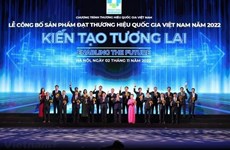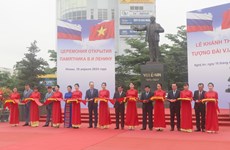First Chau Van singing festival opens in Hanoi
The first festival of Chau Van singing opened in Hanoi on September 25,
aiming to give participants an insight into the nation’s special
traditional art form.
The first festival of Chau Van singing opened in Hanoi on September 25,
aiming to give participants an insight into the nation’s special
traditional art form.
Chau Van, which was created during the Tran Dynasty (1225-1400) and assumably originated from the northern province of Nam Dinh, is mostly performed at temples and pagodas.
The highly rhythmic and trance-oriented form of singing often accompanies “hau dong” (mediumship) during the rituals to honour Mother Goddesses and connect to other gods.
The music and poetry performed in the folk art are mingled with a variety of rhythms, pauses, tempos, stresses and pitches.
The genre has also adopted folk songs from the uplands and highlands throughout the country.
The main musical instrument used in the genre is Dan Nguyet or moon-shaped lute.
The first phase of the event will run until September 30, while the second one will draw the participation of 10 art troupes to perform in the capital from October 4-5.
A number of seminars will be held during the festival to discuss ways to preserve and uphold the values of Chau Van singing in modern society.
The municipal Department of Culture, Sports and Tourism and relevant agencies are working together on a dossier seeking UNESCO’s recognition of the traditional singing genre as an Intangible Culture Heritage of Humanity.-VNA
Chau Van, which was created during the Tran Dynasty (1225-1400) and assumably originated from the northern province of Nam Dinh, is mostly performed at temples and pagodas.
The highly rhythmic and trance-oriented form of singing often accompanies “hau dong” (mediumship) during the rituals to honour Mother Goddesses and connect to other gods.
The music and poetry performed in the folk art are mingled with a variety of rhythms, pauses, tempos, stresses and pitches.
The genre has also adopted folk songs from the uplands and highlands throughout the country.
The main musical instrument used in the genre is Dan Nguyet or moon-shaped lute.
The first phase of the event will run until September 30, while the second one will draw the participation of 10 art troupes to perform in the capital from October 4-5.
A number of seminars will be held during the festival to discuss ways to preserve and uphold the values of Chau Van singing in modern society.
The municipal Department of Culture, Sports and Tourism and relevant agencies are working together on a dossier seeking UNESCO’s recognition of the traditional singing genre as an Intangible Culture Heritage of Humanity.-VNA













